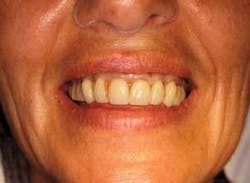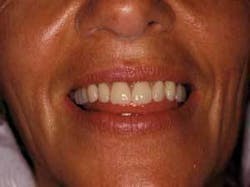Diagnosis First… especially in removable prosthodontics
by Lily T. Garcia, DDS, MS, FACP
As practitioners, we strive to offer patients the best care, which includes providing conventional, traditional, removable prosthodontics. The sophisticated technologies are tools used in the development of patient-centered, diagnosis-driven treatment options, but the quality of patient outcomes still depends on the knowledge and skills of practitioners. We are responsible for assessing new technologies, deciding whether or not to prescribe a specific technology, then providing care for patients - dentate, partially dentate, and edentulous - based on the diagnosis first.
Technological advances are great, but do patients still need removable prosthodontic treatment? The concept that there are fewer people who need removable prosthodontics is false. The distribution of the need varies by region, environment, and socioeconomic status, but the need is there and will continue to exist.
How can we meet the existing need? We must focus on diagnosis-driven treatment planning and technology to improve patient care. This requires a consistent commitment to continuing education.
National assessments of patients who need complete removable prosthodontics and who will need fixed and removable partial prostho-dontics predict a trend for increased needs over the next decades.
The article by Drs. Chester Douglass, Annie Shih, and Larry Ostry, “Will there be a need for complete dentures in the United States in 2020?”1 reviews trends that affect private practices and ramifications important to future dentists who will graduate from accredited U.S. dental schools. The article’s data is based on population projections related to the projected market for determining future oral health needs. The conclusion acknowledges that although there has been a “10 percent decline in edentulism experienced each decade for the past 30 years,” this will be offset by a “79 percent increase in the adult population older than 55 years.”
How does this affect your practice? It means there are patients who need removable prostho-dontic treatment, and for decades there will be patients in need of this care - complete dentures in particular. Dentists must reflect on patients’ needs and decide if they can commit to providing the highest-quality, removable prosthodontic treatment at levels similar to their commitments to providing veneers with exceptional esthetic results.
Many times, our personal negative bias toward removable prosthodontics is based on our experiences with edentulous patients during dental school. When a dental student, new to the clinic experience, is assigned a difficult edentulous patient (Prosthodontic Diagnostic Index = 4; prosthodontic classification index which helps determine degree of difficulty2,3), that student might be justified in a negative bias toward removable prosthodontics. The thought of the most inexperienced clinician tackling one of the most challenging types of removable prosthodontic treatment affirms the potential trend of new general dentists avoiding treating edentulous patients. Yet, these patients are most in need of dentists who are equipped with the knowledge to provide one of the best treatment modalities - the use of implants in removable prosthodontics.
I challenge clinicians to view removable prosthodontics as one of the most important treatment options for patients in their functional and esthetic rehabilitation. It is possible to help patients understand the limits of their expectations based on understanding their diagnoses and conditions. With mutual understanding, patients can be satisfied and learn to manage their outcomes, even with removable prostheses.
The most extreme dental makeover starts with removable complete prosthodontics - complete dentures - because the fundamentals of esthetic analysis require diagnostic evaluation of the patient, extraoral facial esthetics, as well as intraoral esthetics and function.
In many instances, a clinician can provide the best result using conventional, removable prosthodontics in conjunction with implant treatment (Figures 1 and 2). Based on mutual understanding of diagnostically driven treatment options balanced with reasonable patient expectations, an appropriate treatment plan is possible and could include removable prosthodontic treatment options.
According to Douglass et al., there will be a 20-year, unmet prosthodontic need4 specifically related to fixed partial dentures and removable partial dentures. In the article, data of all U.S. prosthodontists and active general dentists who will be available to provide prosthodontic care for patients was evaluated, along with the projected increased need against the “well-documented decline in tooth loss and edentulism in the U.S.”3,4 The unmet need should be a concern because predoctoral dental school programs have been shown to take care of edentulous patients at a disproportionate rate compared to patients with insurance who seek care in general practices.5 The responsibility of dentists in the care and management of partially dentate and edentulous patients is being challenged in dental education. Current curricula in dental schools includes dense course work beyond the training of us who matriculated in the early 1980s.
Foundational knowledge is important from a clinician’s perspective because dental students have limited experiences prior to graduation. New dentists must be lifelong learners, not to continually improve on their abilities but to maintain healthy levels of skepticism in evaluating new technological advances. The fundamental knowledge taught in removable prosthodontics (the essence of esthetic parameters related to fabrication and design of complete dentures and the biomechanical principles taught in removable partial and fixed prosthodontics) is the foundation to evaluate and assess whether or not to incorporate technological advances.
An editorial by Dr. Gordon Christensen6 explores multiple, practical reasons that graduating general dentists will need more exposure to all aspects of prosthodontics. General dentists need strong foundational knowledge in prostho-dontics to take care of patients who present needing complex treatment options, which can include implants. Removable prostheses can be used as part of a transitional treatment plan in an effort to allow patients to seek the best care over time.
As shown in Figures 1 and 2, the definitive treatment for the patient included a maxillary complete denture opposing a mandibular implant overdenture. This care follows the independent report - McGill Consensus Statement - which suggested use of an implant overdenture as the first choice of treatment for the edentulous mandible.7 The statement was based on review of randomized controlled trials, evidence to support the blend of removable prosthodontics with implants for rehabilitation of the edentulous mandible.
The challenge now is to inspire new dentists to continue providing care to meet patients’ needs, especially when considering if patients’ primary treatment options include removable partial or complete prosthodontics. The quote most prophetic in the Douglass article is, “If training in complete denture [prosthodontics] is eliminated from the dental education curriculum, millions of patients will be forced to seek denture services from alternative providers.”1
As the growing number of patients requiring removable partial and complete prosthodontic care in upcoming decades coincides with dental education curriculums decreasing the number of hours dedicated to prosthodontics, all dentists should focus on “diagnosis first.” Subsequently, dentists may consider all treatment options to meet patients’ needs - including providing the best care involving removable prosthodontics for the best possible patient outcomes.
References
- Douglass CW, Shih A, Ostry L: Will there be a need for complete dentures in the United States in 2020? Jour Prosthet Dent 2002;87(1):5-8.
- McGarry TJ, Nimmo A, Skiba JF, et al.: Classification system for partial edentulism. Jour of Prostho-dontics 2002;11(3):181-93.
- McGarry TJ, Nimmo A, Skiba JF, et al.: Classification system for the complete edentulism. Dentistry Today 2001; 20(10):90-5.
- Douglass CW, Watson AJ: Future needs for fixed and removable partial dentures in the United States. Jour Prosthet Dent 2002;87(1):9-14.
- Solomon E, Murray J, Dodge WW, et al.: Scope of Practice Comparison: A tool for curriculum decision making. Jour Dent Ed 2006;70(3):231-45.
- Christensen GJ: Are prosthodontics a vital part of dentistry? Jour Am Dent Assoc 2002;133:647-648.
- The McGill Consensus Statement on Overdentures. Quintessence Int 2003;34(1):78-79.


